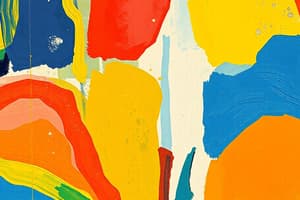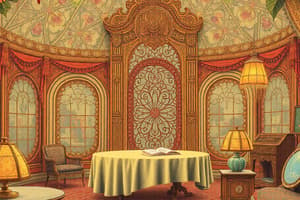Podcast
Questions and Answers
Which characteristic primarily distinguishes literary nonfiction from informational nonfiction?
Which characteristic primarily distinguishes literary nonfiction from informational nonfiction?
- Literary nonfiction focuses on current events, while informational nonfiction explores historical topics.
- Literary nonfiction is shorter and more concise than informational nonfiction.
- Literary nonfiction incorporates narrative elements, while informational nonfiction primarily conveys facts. (correct)
- Literary nonfiction presents unbiased information, while informational nonfiction includes author's opinions.
How does an autobiography differ from a biography?
How does an autobiography differ from a biography?
- An autobiography is written by the subject of the story, while a biography is written by someone else. (correct)
- An autobiography relies on fictional elements, while a biography is strictly factual.
- An autobiography is an informational text, while a biography is a literary text.
- An autobiography covers multiple subjects, while a biography focuses on a single subject.
Which of the following is the primary purpose of informational nonfiction?
Which of the following is the primary purpose of informational nonfiction?
- To provide readers with factual information. (correct)
- To persuade readers with subjective arguments.
- To entertain readers with fictional stories.
- To inspire readers with emotional narratives.
A writer is creating a detailed account of the events leading up to a historical innovation. Which type of nonfiction would be most suitable for this purpose?
A writer is creating a detailed account of the events leading up to a historical innovation. Which type of nonfiction would be most suitable for this purpose?
In what way might a biography and journal differ?
In what way might a biography and journal differ?
A biographer is researching a subject who is still alive. Which of the following research methods would provide the most direct and personal insights?
A biographer is researching a subject who is still alive. Which of the following research methods would provide the most direct and personal insights?
When writing a biography, which of the following strategies would best help a biographer maintain an unbiased perspective?
When writing a biography, which of the following strategies would best help a biographer maintain an unbiased perspective?
Which characteristic most distinguishes an autobiography from a biography?
Which characteristic most distinguishes an autobiography from a biography?
An author is creating a memoir that focuses on their experiences during a year-long journey across South America. Which elements would be most appropriate to include in this type of autobiography?
An author is creating a memoir that focuses on their experiences during a year-long journey across South America. Which elements would be most appropriate to include in this type of autobiography?
A biographer is writing about a controversial political figure. Which approach would best ensure the biography is seen as credible and balanced?
A biographer is writing about a controversial political figure. Which approach would best ensure the biography is seen as credible and balanced?
Flashcards
Nonfiction
Nonfiction
Writing based on facts and reality, not invented stories.
Informational Nonfiction
Informational Nonfiction
Factual texts intended to provide information.
Literary Nonfiction
Literary Nonfiction
Factual information conveyed using literary elements like plot and characters.
Biography
Biography
Signup and view all the flashcards
Autobiography
Autobiography
Signup and view all the flashcards
Subject (of a Biography)
Subject (of a Biography)
Signup and view all the flashcards
Memoir
Memoir
Signup and view all the flashcards
Study Notes
- Nonfiction writing is factual, contrasting with fiction, which involves invented stories.
Types of Nonfiction
- Nonfiction is categorized into informational and literary types.
- Informational nonfiction delivers facts.
- Literary nonfiction uses story elements to present factual information.
Nonfiction Subgenres
- Biography: A life story of a real person; literary nonfiction.
- Autobiography: An author's account of their own life; literary nonfiction.
- Self-help: Advice on specific topics; informational nonfiction.
- Guides and How-to Books: Step-by-step instructions; informational nonfiction.
- Academic Texts: Comprehensive knowledge on a topic; informational nonfiction.
- Journalism: Reports on current events; informational nonfiction.
- Travel Guides: Information for travel to specific places; informational nonfiction.
- Commentary/Opinion: An author's views on events or ideas; informational nonfiction.
- Nonfiction works often include charts, graphs, tables, maps, glossaries, headings, and subheadings.
Biography vs. Autobiography
- A biography details a real person's life, written by someone else.
- An autobiography is the author's own life story.
- Both biography and autobiography incorporate story elements.
- The subject & others are considered characters and the story includes a basic plot & settings.
Nonfiction Biography Components:
- Biographer: The author writing about someone else's life.
- Subject: The person whose life is the focus.
- Third-person point of view: The story told by an outside observer.
Crafting a Biography
- The biographer researches the subject's life.
- Research may involve direct interviews, examining existing interviews, engaging with people close to the subject, and reviewing the subject's writings.
- A good biographer aims to be unbiased, presenting both positive and negative aspects.
- The goal is an accurate, truthful account of the subject's life
Nonfiction Biography Examples:
- True Believer: The Rise and Fall of Stan Lee, by Abraham Riesman: Biography of a comic icon.
- Cokie: A Life Well Lived, by Steven V. Roberts: Biography of a television and radio celebrity.
- Barack Obama: A Biography of an American President, by Jerry Wilson: Biography of a living president.
Nonfiction Autobiography Attributes:
- Autobiographies use the first-person perspective, which may introduce bias.
- Authors might present themselves favorably or aim to persuade readers.
- Memoirs explore specific periods or aspects of the author's life.
- Diaries and journals offer day-to-day accounts, published to show progression of events.
Nonfiction Autobiography Examples:
- Anne Frank: The Diary of a Young Girl, by Anne Frank: Diary during the Holocaust.
- Long Walk to Freedom: The Autobiography of Nelson Mandela, by Nelson Mandela: Life of a South African leader.
- Freckled: A Memoir of Growing up Wild in Hawaii, by TW Neal: A memoir-style autobiography.
Studying That Suits You
Use AI to generate personalized quizzes and flashcards to suit your learning preferences.
Description
An overview of nonfiction writing, contrasting it with fiction. Covers informational and literary categories with biography, autobiography, self-help, guides, and academic texts. Also looks at journalism, travel guides, and commentary.




